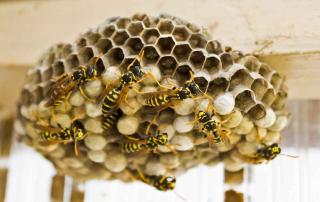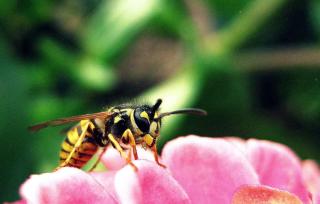

Always a hassle around the picnic basket, sometimes even a painful sting, the wasp doesn’t seem to manage positive vibes, does it? But did you know its larva devours incredible amounts of insect pests that would otherwise damage our plants? So, unbelievably, the wasp is a beneficial insect in the garden, a big help that doesn’t necessarily deserve all the bad press.
Read also:
The term “wasp” actually includes different types of insects. Indeed, the main species of wasp are:
Half an inch long (1 to 2 cm), it has a black and yellow-colored abdomen. Only an extremely thin joint connects the abdomen with the thorax. Its nest is a beige color.
It looks very similar to the common wasp, and it’s difficult to tell the two species apart. One way to do so is to look at the patterns on the abdomen. A much clearer indication is the nest. If you have the chance of seeing one, you’ll notice that its definitely a grayish color for Vespula germanica.
Identical in length to its cousins, umbrella wasps differ from the previous two in that its silhouette seems thinner and the abdomen is sharper at both ends.

Adults feed on nectar and other sweet liquids. Larvae, on the other hand, devour great numbers of insects.

They thus are excellent protector insects for your plants and harvests, especially in the immediate vicinity of the nest.
More often than not, the wasp has a bad reputation and people tend to avoid and even destroy it instead of attracting it. Nonetheless, it’s possible to cohabitate with the wasp, particularly when the nest is located high up in a disaffected portion of the garden. If the nest is high up, wasps won’t feel disturbed by our back and forths.
Trapping wasps with a sweet liquid isn’t a good solution. This is because it’s a wide-ranging trap that is non-selective. Many insects other than wasps are trapped, most of the innocent beneficial insects. It also won’t impact the wasp’s nest because there are so many individuals that picking off a few won’t change much. If you nonetheless want to try such a trap out, replace the sweet syrup with water and a few drops of dishwashing soap, and add something a bit meaty: a bit of cat or dog food, ham… Wasps find meat even more attractive than sugar and other insects don’t.
Lastly, if ever you must remove the nest for safety reasons, call up a professional. Don’t try to do it yourself.
A few misconceptions and myths about the wasp need to be debunked.
Yes. Usually, it stings because it wants to defend its nest or because it feels under attack.
A few things can be done right in the garden:
No. Even though it collects flower nectar for food, wasps don’t make honey.
Getting these two confused is quite common. There are a few big differences between the two: